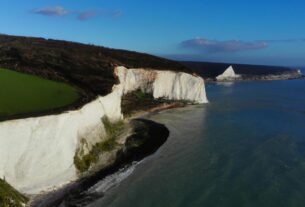When thinking about the world’s most impressive statues, the Ocean Atlas Statue should undoubtedly be at the top of your list. This extraordinary work of art captures the mesmerizing beauty and immense power of the ocean in a truly awe-inspiring manner. Standing tall and proud, the statue has quickly become a beloved tourist attraction, drawing visitors from all over the world.
The Fascinating History of the Ocean Atlas Statue
To truly appreciate the Ocean Atlas Statue, it is important to understand the captivating story behind its creation. Designed and sculpted by the renowned artist Jason deCaires Taylor, this masterpiece is part of his incredible underwater museum located off the coast of Nassau in the Bahamas. Taylor is widely recognized for his thought-provoking underwater sculptures that raise awareness about critical environmental issues.
The Ocean Atlas Statue’s design was inspired by the Titan Atlas, who, in Greek mythology, held up the sky. Depicting a young Bahamian girl bearing the weight of the ocean above her head, the statue symbolizes the responsibility we all share in protecting our planet and its natural resources. It exudes serenity, determination, hope, and resilience in the face of adversity.
The Design and Features of the Ocean Atlas Statue
The Ocean Atlas Statue is not only a work of art but also an engineering marvel. It consists of carefully crafted and assembled pieces that form the final product. Standing at an impressive 18 feet tall, it is one of the largest underwater statues in the world.
Made from a special type of concrete that is designed to withstand underwater conditions, the statue is reinforced with stainless steel and fiberglass, making it exceptionally strong and durable. Every feature of the young girl’s face and body is meticulously captured, showcasing the artist’s incredible attention to detail.
The statue’s location in the ocean just off the coast of Nassau was purposefully chosen to emphasize the significance of the ocean and its vulnerable state. By placing the statue underwater, Taylor creates a unique and powerful statement about the need to protect our oceans and the life they sustain.
The Symbolism of the Ocean Atlas Statue
Beyond its stunning appearance, the Ocean Atlas Statue carries a profound message that resonates with people from all walks of life. It symbolizes the fragility and beauty of our planet’s oceans, gently reminding us of the importance of their preservation. The statue’s powerful imagery and intricate details aim to inspire visitors to take action and make a positive difference in their own communities.
The impact of the Ocean Atlas Statue reaches far beyond its artistic value. It has become a symbol of unity and pride within the local community and has raised awareness about crucial environmental issues. By bringing people together, the statue inspires individuals to become active participants in protecting our oceans and the diverse marine life they harbor.
The Role of the Ocean Atlas Statue in Promoting Ocean Conservation
In recent years, concerns about climate change and human activity’s impact on the world’s oceans have grown. The Ocean Atlas Statue serves as a compelling advocate for ocean conservation. It draws attention to pressing issues such as rising sea levels, ocean acidification, and plastic pollution, fostering awareness and urging immediate action.
Many people remain unaware of the extent of these issues. The statue plays a vital role in promoting awareness by capturing the attention of visitors and compelling them to examine their own responsibility in preserving our planet’s natural resources.
In conclusion, the Ocean Atlas Statue is not only a captivating tourist destination but also a profound symbol of the importance of ocean conservation. With its striking design and powerful message, it continues to inspire individuals and communities worldwide to appreciate, cherish, and protect our planet’s precious oceans.
Sources: National Geographic, The Guardian



